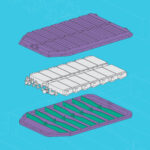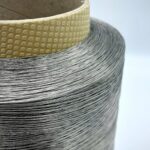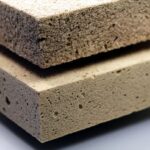A team at the National Institute of Standards and Technology (NIST) has developed a tool to monitor changes in widely used composite materials known as fibre reinforced polymers (FRPs), which can be found in everything from aerospace and infrastructure to wind turbines. The new tool, integrated into these materials, can help measure the damage that occurs as they age. “This gives us the ability to develop better, more fatigue-resistant composites,” said NIST chemist Jeff Gilman. “We can see when the fibre starts to break. We now have a way to quantify the damage.”
Since the 1960s, scientists have been experimenting with ways to make FRPs lighter and stronger. This has often meant testing the bond between fibre and resin. As reported in a previous publication, the NIST team added small molecules that fluoresce after the impact of mechanical force. These molecules, called “mechanophores,” change colour or light up, helping identify tiny nanometer-sized openings or cracks between the fibre and resin.
The NIST team has taken this technology to the next level by incorporating the mechanophore throughout the composite resin. Although not noticeable to the naked eye, the newest approach allows scientists to use special microscopy imaging techniques to measure FRP damage. The approach incorporates a minute amount (less than 0.1% mass) of a fluorescent dye called rhodamine that causes no appreciable changes in the material’s physical properties.
If the new mechanophore is embedded in structures made of FRP, field testing for fatigue could be done inexpensively and on a regular basis. Structures like wind turbines could frequently be scanned easily for interior cracks, even years after they’ve been erected.
Initial work with this new tool also revealed a surprise about FRP damage. When a fibre breaks, it sends out a kind of “shock wave” that moves throughout the material, explained Jeremiah Woodcock, the lead author of a new paper about the mechanophore published in Composites Science and Technology. In the past, it was believed that most of the damage was happening at the point of breakage.
“We thought that when we looked at the results, there’d be a halo of light around the crack, showing the fluorescence of the mechanophore,” Woodcock said. Instead, they found that damage occurs in places that are very remote from the point of fibre fracture. “It’s like we knew about the earthquake but didn’t know about the tsunami that follows after it.”
The NIST mechanophore research also found that existing testing was unintentionally damaging the material’s strength. This has, in turn, led designers and engineers to overdesign FRPs. Using the mechanophore could, therefore, bring down energy and manufacturing costs and increase the ways these materials are used in industry.
Source: https://phys.org/
Author: Alison Gillespie, National Institute of Standards and Technology












